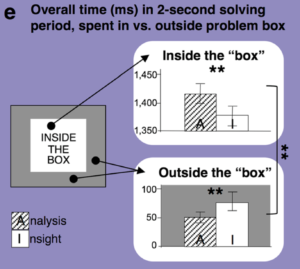Did you ever wonder why Winnie-the-Pooh tends to close his eyes when he tries to come up with yet another genius idea (like turning himself into a little black rain cloud to trick some bees)? Is he just trying to think really hard despite all the fluff in his head or turning away from the distracting world while waiting for a sudden insight to solve his problem?
In a recent study published in they Psychonomic Bulletin & Review, researchers Carola Salvi and colleagues might have found the answer. They investigated the relationship between attentional deployment and problem solving by tracking eye movements. The authors were specifically interested in whether sudden insight —those “Aha!” moments — and analytic problem solving coincide with different ways of attending to or away from the outside world.
For this purpose, they tracked eye movements while participants were trying to solve compound remote associates (CRA) word problems. CRA problems consist of the simultaneous presentation of 3 words, e.g. “crab”, “pine”, “sauce”. Solving the problem involves finding a 4th word that could — combined with each of the three problem words — form a common compound word or two-word phrase; in this case that would be “apple” forming “crab apple”, “pineapple”, “apple sauce”. This type of problem tends to be solved in one of two ways: with insight or analytically.
Solving with insight was described as follows: “The answer suddenly comes to mind even though you are unable to articulate how you achieved the solution. Sometimes this is called the Aha! moment.” Solving analytically was described in these terms: “You deliberately and consciously tested out different words until you found the solution, and you are able to report the steps that you used to reach the solution.”
Previous neuroimaging and EEG work had shown solving a problem via sudden insight, is characterized by attention shifting away from the visual presentation of a problem and toward internal processing. Here, Salvi and colleagues used three eye-tracking measures as an indicator of different attentional settings: blinking, fixation frequency, and fixation location. Introspection tells us that people tend to look at a blank wall, out the window, or shut their eyes altogether, to avoid distraction from our visual surroundings.
In addition, blinking not only reduces the amount of information entering the system, but also seems to cortically suppress visual processing. Accordingly, the authors suggested that shifting attention inwards would result in increased blink frequency and duration while avoiding directly looking at the problem, literally “thinking outside of the box”.
Three time windows of successfully solved problems were considered for eye movement analyses: (1) preparation 2 s prior to the presentation of each problem; (2)onset: the first 2 s following problem presentation; and (3) solution: the 2 s prior to successful solving. Broadly speaking, eye-tracking measures indicated that during the preparatory and/ or solution periods, overt attention differed when participants solved problems by insight versus when they solved by analysis. How so?
First of all, the authors report higher blink rates in the preparation period, associate these with increased insight solving, and speculate that this relationship could be related to an increase in dopamine function (which in turn is highly associated with the cognitive processes of attention and cognitive control). As soon as the problem appeared on the screen, however, differences between insight and analytic problem solving disappeared, due to having to actually deal/look at the words that constitute problem. Finally, just before solving the problem people blinked more often and longer when they solved following sudden insight rather than analytical thinking. And while “people generally remained looking at the problem words—that is, in the box (see the figure below)—they spent more time looking outside the problem box just before solving by insight than just before solving by analysis.”

In other words, in order to solve a problem creatively, one needs to switch off external processing of the problem stimulus and focus internally as seen in the increased blinking, decreased frequency of eye movements, and “literally moving the eyes away from a problem stimulus just before the solution bursts into consciousness”. So “thinking outside of the box” might literally entail “looking outside of the box”.
Reference for the article discussed in this post:
Salvi, C., Bricolo, E., Franconeri, S. L., Kounios, J., & Beeman, M. (2015). Sudden insight is associated with shutting out visual inputs. Psychonomic Bulletin & Review. DOI: 10.3758/s13423-015-0845-0.

1 Comment